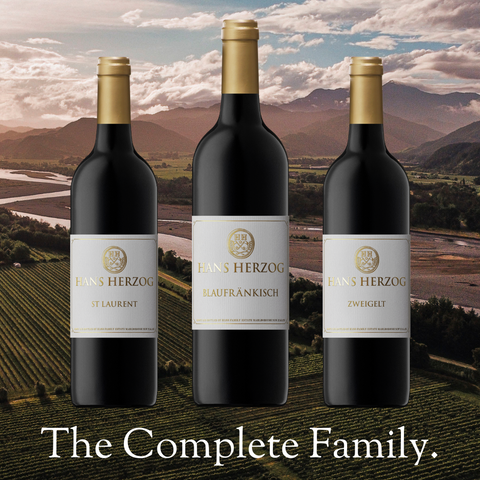
The wines of the Franks and the birth of Blaufränkisch in New Zealand.
The release of Blaufränkisch completes the legendary Austrian family in our single organic vineyard. Parents Blaufränkisch and St Laurent with offspring Zweigelt, extraordinary wines from an exceptional producer.
Blaufränkisch - is the Austrian name for the increasingly respected middle European black grape variety the Germans call Lemberger. From pre-medieval times it was common to divide grape varieties into the (superior) ‘fränkisch’, whose origins lay with the Franks, and the rest. (J.R.)
Blossoming during the Austro-Hungarian empire, Blaufränkisch leaves no doubt about its supremacy - the Habsburg empire has born a wine of royal blood, somehow ethereal and utterly seductive.
A pedigree shared with the name ‘Herzog’, believed to have originated around the 12th century in Vienna according to Hans’ ancestors. A multi-generational journey over the centuries. A wine history unfolding from the rugged Rhine valley in the 14th century to the gravelly riverbeds of Marlborough in the 19th. Changing 500 years of winegrowing legacy to pursue the dream of the perfect terroir to make truly outstanding wines, able to stand amongst the world’s best is no mean feat. But then, Hans Herzog is indeed a unique story, shy and introverted but continuously pushing the boundaries of New Zealand’s wine industry with new blends and grape varieties. A quiet achiever, never out for accolades and fame, but highly respected by his peers.

His name is on the bottle. His story is in it…
Discovery. Back in the 90ties, nurseries didn’t always know the heritage of their vines which didn’t deter Hans’ experimentalist stance to explore some obscure varieties. The seductively spicy Austrian grape variety ‘Zweigelt’ was only one of them. As the Zweigelt vines grew, Hans observed two vines being distinctively different. Similar leaves but smaller, loose bunches with smaller berries. The rich flavoured grapes budded earlier but ripened later and tasted slightly more peppery with a tendency to coulure. Initially assuming it to be a different clone, exploration over the years hinted to a different variety, most likely the noble Blaufränkisch, a parent of Zweigelt (the other being St Laurent). Further confirmed by visiting vignerons from Burgenland, ancestral home to both varieties, Hans started to painstakingly taking budwood from the two vines to graft it on other vines.
Setback & Perseverance. Over the years Hans realized that one of the two original vines was more prone to ‘coulure’*, with its grafted offspring’s showing the same poor fruiting pattern. A painstakingly work of marking the vines which consistently failed to crop ensued over many years. By ‘sélection massale’, budwood was now taken only from the strongest and most reliable Blaufränkisch vines and top grafted ones again. Decades of meticulous vineyard selection cumulated in 2019, when we finally handpicked enough of the precious grape variety to fill one French Barrique. A bold but divinely elegant wine was born, showing off the typicity of the variety with vibrant spicy aromas, balanced by deep, nearly brooding tannins lifted by a bright and lively acidity highlighting every nuance of fruit and spice.
Validation. Before releasing the wine, we sought a DNA test to validate the grape variety which proved impossible in New Zealand with no comparison available. In Spring 2021, the imprint of young Blaufränkisch leaves was sent for DNA to the ‘Plant Identification Lab and Foundation Plant Services’ of the highly prestigious University of California Davies (UDC). In January 2022 we finally received positive identification and Blaufränkisch (aka Lemberger) became a new grape variety for New Zealand.
Creating legends. In June 2022, the fruit of many years of labour could finally see the light of the day and the small parcel of Blaufränkisch born in Marlborough finding its way to wine lovers!
*(Poor fruit set due to excessive shedding of ovaries and young berries resulting in relatively few berries per bunch, either during or soon after flowering).
Hans Herzog - dedicated to creating distinct and memorable wines that tell our story of time and place with each sip.
